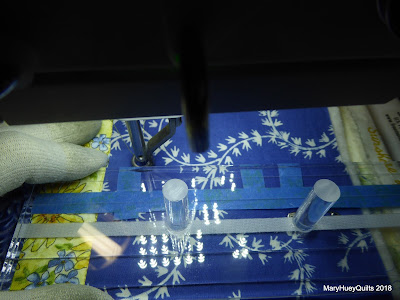The information for the current challenge quilt for the fourth issue of Curated Quilts has been laying on my cutting table all month with this little stack of prints out of my stash.
I had a germ of an idea -- to recreate my LIFT OFF design (introduced HERE) in a smaller scale but really was struggling with the color combination -- not into it at all.
I put the fabrics away having decided not to struggle against my instincts and then this print surfaced in my stash while looking for something else.
It's that color combination mostly -- a bit brighter than the palette in the information but it's the same!?!
Yea, I'm in!
I used the Lazy Girl Flying Geese tool this time -- I like it for small scale geese -- and got to work!
My results with this technique are good and the "larger" pieces of fabric are easier to use.
I made 1 1/2" by 3" units this time
LIFT OFF only needs 20 geese, so I had it laid out in no time.
There are measurements in the guide I wrote (buy it in my Etsy shop HERE and support my charity quilt gang's batting fund!!) for quilts using six different sizes of geese. The smallest is 12" by 18" finished -- perfect for a mini!!
An afternoon of stitching had it ready to layer and quilt -- what color of thread to use?
I can't believe I had three choices since I don't typically work in such a saturated palette.
When I came back to it the next morning, I had decided to go with vertical "matchstick" quilting and use all three thread colors -- easier than making a decision and I like quilts I see on Instagram and Pinterest where several thread colors are used.
I started with randomly spaced lines of the fuchsia.
This looked good.
Next came the blues and most of those lines are centered between the fuchsia lines -- once that positioning decision was made, the quilting went quickly!
Better!!
Finally, the orange thread.
I inserted these lines randomly, adding them where it felt right!
I can't believe this quilt is being made by me -- look at all that texture?
Here's a closer look at the quilting. As I began, I confess to feeling hesitant but if I don't experiment with ideas, how will I know if they work for me? So forward I went!
I love the spark the orange thread adds!!
I squared it up at 14 1/2" and auditioned all four of the geese prints -- they all looked fine but I preferred the green.
And I added those clever little corner pockets for hanging while binding it!
It's finished!!
The pieced design disappears since all the fabrics are the same value -- mediums. I'm surprised the orange pops out since it's so close on the color wheel to the fuchsia -- it must be just slightly lighter in value. It's definitely saturated color!!
I'm going to enter it into the challenge even though it's quite different and a little harder to look at than most of the entries which are more subtle and sophisticated. I hope other "traditional" quilters are inspired to try out some modern techniques and ideas for the creative boost it gives one! I'm glad I made it -- now I know the small size of LIFT OFF works beautifully for a mini and I love the results of the multi color threads quilting experiment -- I'll definitely do that again!!
It was fun!!
Best of all -- I used up every inch of that bright paisley which I don't know why I bought it in the first place!?!
You can check out all the entries for yourself HERE at Curated Quilts!
Happy Easter
Mary


































































